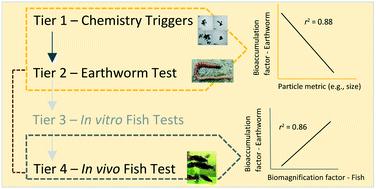当前位置:
X-MOL 学术
›
Environ. Sci.: Nano
›
论文详情
Our official English website, www.x-mol.net, welcomes your feedback! (Note: you will need to create a separate account there.)
The bioaccumulation testing strategy for manufactured nanomaterials: physico-chemical triggers and read across from earthworms in a meta-analysis
Environmental Science: Nano ( IF 7.3 ) Pub Date : 2021-10-04 , DOI: 10.1039/d1en00444a R. D. Handy 1 , N. J. Clark 1 , J. Vassallo 1 , C. Green 2 , F. Nasser 2 , K. Tatsi 1 , T. H. Hutchinson 3 , D. Boyle 1 , M. Baccaro 4 , N. van den Brink 4 , C. Svendsen 5
Environmental Science: Nano ( IF 7.3 ) Pub Date : 2021-10-04 , DOI: 10.1039/d1en00444a R. D. Handy 1 , N. J. Clark 1 , J. Vassallo 1 , C. Green 2 , F. Nasser 2 , K. Tatsi 1 , T. H. Hutchinson 3 , D. Boyle 1 , M. Baccaro 4 , N. van den Brink 4 , C. Svendsen 5
Affiliation

|
Little is known about the bioaccumulation potential of manufactured nanomaterials (MNs). For traditional chemicals, the Organisation for Economic Co-operation and Development (OECD) Test Guideline (TG) 305, bioaccumulation in fish is often used. However, for MNs, there are no approved processes to trigger or waive this test, or consider alternatives to vertebrate animals. The aim of the present study was to conduct a meta-analysis of existing data sets on particle properties and bioaccumulation in earthworms to understand what particle metrics could be used as a trigger for bioaccumulation testing. An apparent steady state tissue concentration of metal from MNs exposure in the earthworm (Eisenia fetida) was evident following exposures to Ag nanoparticles (NPs), CuO NPs and CdTe quantum dots (QDs). This allowed the derivation of nano bioaccumulation factors (nBAFs), calculated using soil and earthworm tissue metal concentrations. A prediction equation using all the particle metrics correlated with BAFs was possible. Similarly, nano biomagnification factors (nBMFs) were calculated in the rainbow trout (Oncorhynchus mykiss) tissue, relative to the concentration of total metals in the fish diet. Pearson's correlations were found to be significant, with p < 0.05 for nBMFs for the liver, mid intestine, hind intestine and kidney relative to the earthworm tissue nBAFs. Together these data indicate that bioaccumulation measurements in earthworms for metallic MNs could be predictive of those values in fish, and that there is scope to predict the bioaccumulation potential of MNs with confidence from a few simple particle metrics.
中文翻译:

人造纳米材料的生物积累测试策略:荟萃分析中的物理化学触发和从蚯蚓中读取
人们对人造纳米材料 (MNs) 的生物积累潜力知之甚少。对于经济合作与发展组织 (OECD) 测试指南 (TG) 305 中的传统化学品,经常使用鱼类中的生物积累。但是,对于 MN,没有批准的流程来触发或放弃此测试,或考虑替代脊椎动物。本研究的目的是对有关蚯蚓中粒子特性和生物积累的现有数据集进行荟萃分析,以了解哪些粒子指标可用作生物积累测试的触发因素。蚯蚓(Eisenia fetida) 在暴露于 Ag 纳米粒子 (NPs)、CuO NPs 和 CdTe 量子点 (QDs) 后很明显。这允许推导使用土壤和蚯蚓组织金属浓度计算的纳米生物蓄积因子 (nBAF)。使用与 BAF 相关的所有粒子度量的预测方程是可能的。类似地,相对于鱼类饮食中总金属的浓度,计算了虹鳟鱼 ( Oncorhynchus mykiss ) 组织中的纳米生物放大系数 (nBMF) 。发现 Pearson 的相关性是显着的,p相对于蚯蚓组织 nBAF,肝脏、中肠、后肠和肾脏的 nBMF < 0.05。这些数据一起表明,蚯蚓中金属微晶元素的生物积累测量可以预测鱼类中的这些值,并且可以通过一些简单的粒子指标有信心地预测微晶元素的生物积累潜力。
更新日期:2021-10-04
中文翻译:

人造纳米材料的生物积累测试策略:荟萃分析中的物理化学触发和从蚯蚓中读取
人们对人造纳米材料 (MNs) 的生物积累潜力知之甚少。对于经济合作与发展组织 (OECD) 测试指南 (TG) 305 中的传统化学品,经常使用鱼类中的生物积累。但是,对于 MN,没有批准的流程来触发或放弃此测试,或考虑替代脊椎动物。本研究的目的是对有关蚯蚓中粒子特性和生物积累的现有数据集进行荟萃分析,以了解哪些粒子指标可用作生物积累测试的触发因素。蚯蚓(Eisenia fetida) 在暴露于 Ag 纳米粒子 (NPs)、CuO NPs 和 CdTe 量子点 (QDs) 后很明显。这允许推导使用土壤和蚯蚓组织金属浓度计算的纳米生物蓄积因子 (nBAF)。使用与 BAF 相关的所有粒子度量的预测方程是可能的。类似地,相对于鱼类饮食中总金属的浓度,计算了虹鳟鱼 ( Oncorhynchus mykiss ) 组织中的纳米生物放大系数 (nBMF) 。发现 Pearson 的相关性是显着的,p相对于蚯蚓组织 nBAF,肝脏、中肠、后肠和肾脏的 nBMF < 0.05。这些数据一起表明,蚯蚓中金属微晶元素的生物积累测量可以预测鱼类中的这些值,并且可以通过一些简单的粒子指标有信心地预测微晶元素的生物积累潜力。


























 京公网安备 11010802027423号
京公网安备 11010802027423号